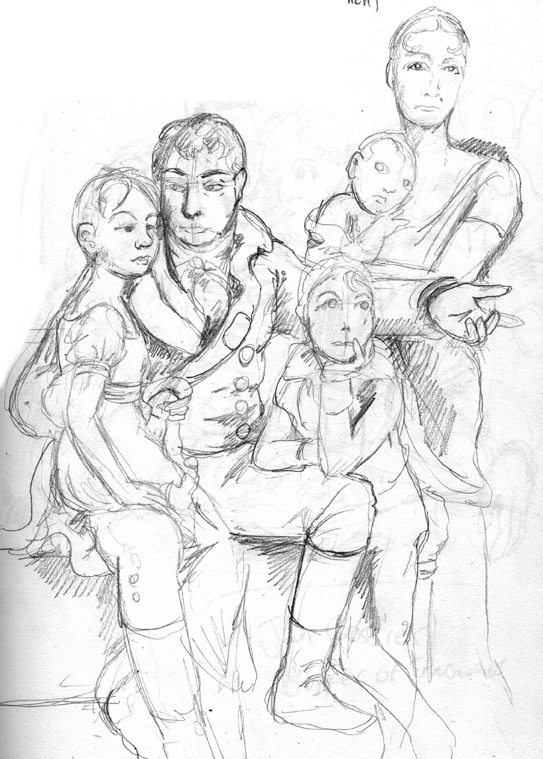 Today’s sketch is another one from the RISD Museum‘s main gallery. Jacques-Luc Barbier-Walbonne, Portrait of Antoine-Georges-Francois deChabaud-Latour and Family. 1806
Today’s sketch is another one from the RISD Museum‘s main gallery. Jacques-Luc Barbier-Walbonne, Portrait of Antoine-Georges-Francois deChabaud-Latour and Family. 1806
This one is fun. Not only is it a beautifully crafted piece, that took me an hour to get right, but it’s an example what I like to think of as literalism in portraits. What I mean is that either the artist meant to put an editorial comment into the painting, or it was something he missed, engrossed in every tiny detail, or it’s just the case of our future eyes misunderstanding what a creator from a couple of centuries past was going for… My point is that the painting tells us something that the artist probably hadn’t intended.
This is why I like this piece. Clearly Mr. Barbier-Walbonne created what he was commissioned to do, paint the portrait of a successful plantation owner who was the proud paterfamilias to his family. But when I look at this painting my eyes continue to be drawn back to the children… Who are clearly bored out of their minds. 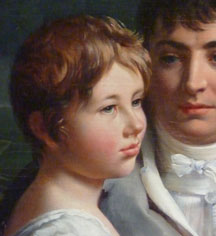
I’m a big fan of both the Daily Show and The Colbert Report. Because of this I have a bad habit of looking for news articles about especially good bits. Most of the time they’re just showing the clip but occasionally they provide interesting comments.
So anyway, I was doing this after the Daily Show’s latest bit on Wisconson today and the first headline I saw was;” Jon Stewart’s hysterical defense of teachers.” My immediate response was, “Hey! Whatever you think about the demonstrations, Stewart’s response wasn’t hysterical! It was done in his usual sarcastic deadpan!”
Then I actually read the article and then, slightly embarrassed I said “Oh yeah. Hysterical also means really funny. That makes sense since Jon Stewart is, you know, a comedian.
| The Daily Show With Jon Stewart | Mon – Thurs 11p / 10c | |||
| Crisis in Dairyland – Message for Teachers | ||||
|
||||
Something new I’m trying. As you probably know, the title of the strip, Rhapsodies, is referring to Rhapsody: “a musical composition of irregular form having an improvisatory character.” I like that definition. It was a definition I could turn into a metaphor, a metaphor that I could use as the entire concept behind the strip.
The word, Rhapsody has several other definitions, all useful but for the time being I’ll stick to the musical definition.
When I first envisioned the concept. I didn’t have the grand concept behind the title. I chose Rhapsodies for two reasons. Reason number one was that at the time Paul was the main character, Paul was a musician so I wanted a musical title. The other reason was before I started doing it as a comic strip, I was imagining Rhapsodies as my vision of what a sitcom should be. Because of the musical theme, I imagined the credits being done to Rhapsody in Blue with a montage of clips of the setting. (In hindsight I confess I was going through a Woody Allen phase and I’d seen Manhattan one too many times) Essentially Rhapsodies was a name of convenience to label your strip with. Like “Peanuts”or “Zits”, actual relivance didn’t matter.
But as time progressed, I liked the way you could turn the musical definition of Rhapsody into a metaphor that embraced the entire strip, even the parts that had nothing to do with the music.
Getting back to the music, though I thought I would start to share some other Rhapsodies. Everything from the classics to the cutting edge. Some obvious, others pieces that were never considered rhapsodies but fit the definition perfectly.
Since I mentioned it already I thought I’d start with one of the greatest works in American music, George Gershwin’s Rhapsody in Blue.
The clip I’m using is the one from Disney’s Fantasia 2000. Compared to the original, I didn’t care for the 2000 sequel. From a technical perspective the animation and graphics were cutting edge, but otherwise I found it lacking, a prime example of form over content.
The Gershwin segment was the exception. I’ve always been a fan of Al Hirschfeld and this was a loving tribute to him. But also I liked how the story, along with Hirschfeld’s characters created a portrait of New York as seen from magazines like the New Yorker at the time.
So without further Ado George Gershwin’s Rhapsody in Blue.
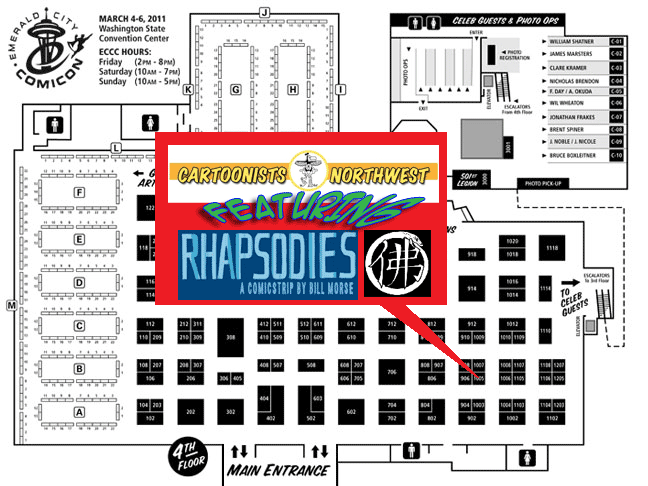 Well everybody, the week of the Emerald City Comicon has finally arrived! I’ll be at Cartoonists Northwest booth (#1005 see map plugging the strip and selling the new book. I look forward to see all of you and meet lots of new people!
Well everybody, the week of the Emerald City Comicon has finally arrived! I’ll be at Cartoonists Northwest booth (#1005 see map plugging the strip and selling the new book. I look forward to see all of you and meet lots of new people!
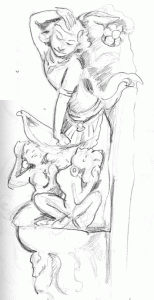 Okay for this week’s museum sketch we take you to the the Seattle Asian Art Museum and their wonderful Indian Sculpture gallery. I always like drawing in this room. First of course because of the great selection of Greco-Indian Sculpture from northern India, and second, since the room doubles as the museum’s bistro. I have the luxury of sitting down with my sketchbook resting on a table when I draw which yields a much better image.
Okay for this week’s museum sketch we take you to the the Seattle Asian Art Museum and their wonderful Indian Sculpture gallery. I always like drawing in this room. First of course because of the great selection of Greco-Indian Sculpture from northern India, and second, since the room doubles as the museum’s bistro. I have the luxury of sitting down with my sketchbook resting on a table when I draw which yields a much better image.
So what we have today is a statue of Kama, the Hindu God of Love (more accuratly Kamadeva, aparantly Kama also refers to the concept.
The statue is from Orissa in the 11th Century and done in sandstone. More details here.
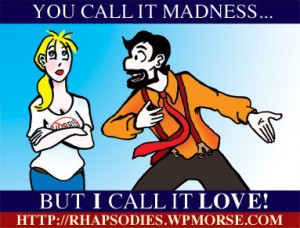 Well just finished restocking on books and promotional materials for the Emerald City Comic convention. Including a new promotional postcard. This is a huge relief, I always feel like I put all of this off until the last minute and end up spending the last remaining weeks stressing out about whether everything will get to me on time.
Well just finished restocking on books and promotional materials for the Emerald City Comic convention. Including a new promotional postcard. This is a huge relief, I always feel like I put all of this off until the last minute and end up spending the last remaining weeks stressing out about whether everything will get to me on time.
I’ll be with the Cartoonists Northwest Table at #1005 Come and see me, I’m looking forward to it!






